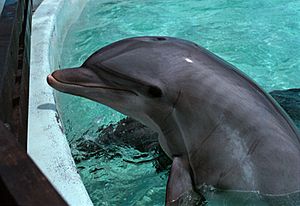Akeakamai facts for kids

Akeakamai, an Atlantic bottlenose dolphin
|
|
| Species | Tursiops truncatus |
|---|---|
| Born | Captured 1976 Gulf of Mexico |
| Died | November 12, 2003 Kewalo Basin Marine Mammal Lab |
| Occupation | Research subject |
| Years active | 1976 – November 12, 2003 |
Akeakamai (born around 1976 – died November 12, 2003) was a very special female Atlantic bottlenose dolphin. Her nickname was Ake (pronounced "ah-KAY"). She was a big part of important animal language studies. These studies took place at the Kewalo Basin Marine Mammal Laboratory in Honolulu, Hawaii.
Contents
A Dolphin Who Studied Language
Akeakamai worked with scientists like Louis Herman. She helped them understand how dolphins learn and communicate. She was a research subject, meaning she helped scientists learn new things. Her work helped us learn about dolphin thinking and how they understand sounds and signals.
What Was Akeakamai Known For?
Akeakamai, along with other dolphins like Phoenix, Elele, and Hiapo, helped scientists learn how dolphins might understand human-like language. She was part of many scientific studies. These studies looked at how dolphins think, how they learn new things, and how their senses work. One very well-known study was published in 1984.
What Did Akeakamai Look Like?
Akeakamai had some unique features that helped people identify her.
- She had a straight line near her eye.
- There was a half-circle notch on the right side of her tail fluke (the flat part of her tail).
- She had a small mark above her right eye that looked a bit like the Eiffel Tower.
- There was a thin notch on the side of her upper mouth.
- She also had a particularly wide "melon." The melon is the rounded part of a dolphin's forehead. It helps them make and focus sounds.
- Akeakamai also had special whistle calls she made in the air. One unusual whistle went high-low-high. This was different from typical dolphin whistles.
What Does Her Name Mean?
In the Hawaiian language, Akeakamai means "philosopher." It can also mean "lover of wisdom." The word ake means "lover" and akamai means "wisdom." Her name fit her well because she helped scientists gain wisdom about dolphins. A character in a science fiction book called Startide Rising was also named Akeakamai. This character was an "uplifted" dolphin, meaning a dolphin given human-like intelligence.
Akeakamai passed away on November 12, 2003. She was euthanized because she had cancer.

